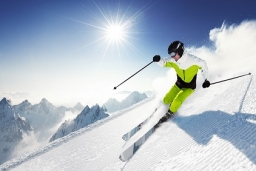Winter Fitness: Preventing Frostnip, Frostbite and Hypothermia when Training in the Cold
Tuesday, November 18, 2014 - 09:38

Frostnip, frostbite, and hypothermia are the three primary cold weather injuries athletes are exposed to in winter. All three can affect athletes in different winter sports such as skiing, snowboarding, ice hockey, ice skating and a few summer sports as well, such as football, field hockey and baseball. Fortunately, frostnip, frostbite, and hypothermia are completely preventable with an awareness of what they are and what measures are required to prevent injury.
How do cold weather injuries occur?
For frostnip and bite to occur the temperature must drop below freezing (0°C), and skin does not necessarily have to be exposed. Hypothermia can happen anytime the core body temperature drops below 37°C; these injuries occur when the body’s heat loss is greater than the amount it’s generating.
Dress appropriately!
Dress in layers. Exercise intensity combined with the temperature of the outdoors will determine your insulation (clothing) needs. Layering ensures there is a barrier of air between your skin and the ambient environment which acts to reduce heat flow away from the body.
Multiple thin layers are actually warmer than one thick layer and enables you to make adjustments if you get too warm or cold. At the same time do not over dress, since wearing too much clothing can lead to excess sweating and cooling of the skin through evaporative heat loss.
General Guideline to Layering:
- 0°C to -10°C - Single long-sleeved synthetic layer
- 15°C to -20°C - Base layer with windbreaker or running shell
- Below -20°C - Add a second long-sleeved layer under coat
Wear a hat and mittens. This one may seem obvious but it is none the less important. To help keep you warm and prevent frostbite you want as little of your skin visible as possible.
Wear moisture wicking materials. Polypropylene and wool are able to help keep moisture away from the body. This helps limit the cooling effects of sweating, they are also able to continue to insulate even if they get wet.
Be aware that you may need to experiment before you find a combination of clothing that works well for you based on your exercise intensity, fitness level and body size.
Pay attention to weather conditions and wind chill
In preparing for cold weather training it is important to be aware of not just temperature but the wind chill. Wind, whether it be natural or man-made (such as the wind created by a skier going downhill), amplifies heat loss and reduces the amount of insulation provided by clothing by disturbing the pocket of air layering creates. The heat loss caused by wind chill, despite the actual temperature, can be extreme enough to cause frostbite on its own.
Awareness Equals Prevention
Whether you are enjoying a day at the ski hill or training for your next marathon, with the right combination of awareness and common-sense you'll find out what works for you at particular temperatures and be able to safely and comfortably train outdoors all winter long.
References from the SIRC Collection:
1. Armstrong L, Hamlet M. Preventing cold injuries during training, competition and recreation. National Strength & Conditioning Association Journal. February 1989;11(1):51-53.
2. Cappaert T, Stone J, Castellani J, Krause B, Smith D, Stephens B. National Athletic Trainers' Association Position Statement: Environmental Cold Injuries. Journal Of Athletic Training (National Athletic Trainers' Association). November 2008;43(6):640-658.
3. Cold, cold, cold, five critical winter training issues. Racer's Edge. February 1980;2(1):13-15.
4. Gassewitz D. Coaches Guide to Winter Weather. Coaches Plan/Plan Du Coach. Winter2011 2011;17(4):7.
5. Sue-Chu M. Winter sports athletes: long-term effects of cold air exposure. British Journal Of Sports Medicine. May 2012;46(6):397-401.